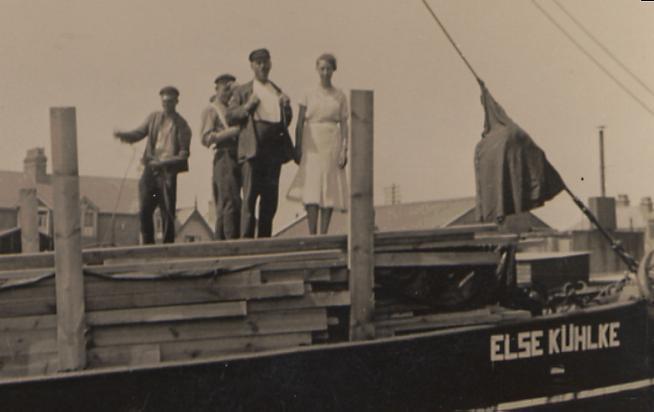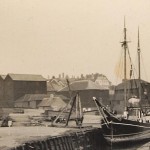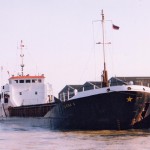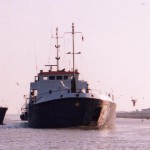“Timber boats” as they were known locally, were a common sight at The Strand in the years between the Wars. By 1934 Hitler had sole charge of Germany and a programme of re-armament began. This effort required vast amounts of raw materials and soon the German coasters that brought in the timber were re-loaded with scrap metal from the Gasson’s scrap pile close to Brede Sluice.
These pictures are of the Elese Kuhlke and the family who lived on her and crewed the coaster.
Germans brought Timber in and took Metal out
Arthur Woodgate’s recollections of the Second World War have brought these amazing pictures to light. Arthur told us that on the day the War started, Sunday 3 September 1939, a German ship was berthed in the Strand flying the German flag and the Swastika. These three pictures, loaned by Frank Palmer show the German coaster ELSE KUHLKE standing empty after discharging a shipment of timber for Hinds Timber Yard.
Could this have been the same German coaster that took her chance and made off back to Hamburg on that momentous day?
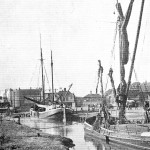
frequently for timber deliveries, “
“, she sailed under the British Flag,
having been taken as ‘spoils of War’ in
1919
Our researches have discovered this could not have been the case. The ELSE KUHLKE entered Rye on 17 May 1933 and put back to sea on 30 June 1933. She flew the Swastika from the bow sprit as she sailed away over the horizon, but as this was one full year before Hitler took absolute power in Germany we must assume that the collection of scrap had not begun. The height the Else Kuhlke was riding in the water as she left Rye Harbour (right) suggests she was empty. The Captain was obviously a Nazi supporter as the Swastika can be clearly seen flying from the bowsprit.
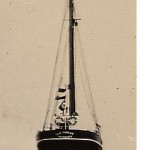
Just over two years later, on 25 September 1935, she sank off the Dutch coast. Her cargo by that time could well have been scrap metal from Rye which may well have caused her demise. There are no other details of her sinking except for her position. Lat; 53’17. 4xx’ N Long; 004’50.6xx’ S.
There were other German coasters that ran timber into Rye and left with a cargo of scrap iron. As Arthur explained in his article, the skipper would bring his family with him and those that came regularly became friendly with the town’s people.
After WW2
The supply of timber from Scandinavia to Thomas Hinds & Sons was resumed after the War but this time there were no return cargoes of scrap metal and the coasters did not fly a Swastika. German coasters returned on many occasions and the Captains and their families were made welcome.
The ANNA, was one of those that were frequent visitors to The Strand. By this time the only cargo that was being imported to Rye by sea was timber for Hinds. The Hinds sons, Bert and Frank were now in charge and ran the firm with efficiency. They earned Another German coaster (left) using Rye frequently for timber deliveries, ” “, she sailed under the British Flag, having been taken as ‘spoils of War’ in 1919 ELSE KUHLKE, sails out of Rye Harbour flying the German National flag and the Swastika respect from their staff, most of the men worked for them over a great period of years. Bert was the tough guy of the two, his word was law. Frank was much softer and was known on occasion to slip a few extra pounds into the hands of junior casual workers (under 18), who sometimes made up part of the casual team unloading the timber boats, if he thought they had worked as hard as the men.
Sadly, Frank suffered from a painful progressive illness and took his own life in the Gungardens, using a service revolver. He didn’t want to be a burden. He left a note and £3 with instructions, it was to go to the person who had to clean up the mess. He was a gentleman to the end.
Bert carried on the business himself, his son-in-law Mr. Mc Cullaugh took over when he retired but died after a comparatively short period of taking over. His son carried on. Suicide struck the firm again in 1973, the lad, possibly because he was out of his depth running such a complex business, took his own life.
Around this time the giant Alsford Company was completing work on a large development at Rye Harbour including a wharf and a warehouse complex. Soon larger coasters than could have got up into The Strand were bringing in timber for Alsfords network of businesses and consumers. They purchased the Hinds company and for some period of time timber was still stocked, stored and processed from the yard. Then, Alsfords purchased the old bus depot and transferred the Rye work to the new site.
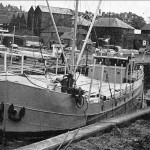
loads were coming in each summer at that time.
Photo by Peter Steed
The new Wharf at Rye Harbour attracted quite a bit of work and carried on the tradition of sea trade using the Rother. All went well until the recession of the late eighties. The Alcor W. unloading timber for Hinds & Sons. 1967. Two loads were coming in each summer at that time. Photo by Peter Steed A 1950’s cargo being unloaded on the Strand Quay. Alsfords ran into difficulties and the Wharf ceased operating. For nine years not one coaster came to the Rother and a centuries old era seemed to be coming to a close. The whole Rye Harbour trading area wound down as business after business failed or drastically cut back.
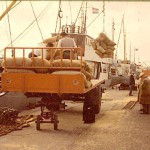
on the Strand Quay.
Then in 1999 Rod Chapman, who had spent his lifetime running quarries and had 50 trucks supplying building materials, saw an opportunity and decided he would have a go at operating a wharf.
Along with Dick Benge he formed a company, Rastrum, to run the shipping and cargos. The first cargo arrived in May 1999, when the largest ship ever to come to Rye was guided in by Harbour Master Captain Carl Bagwell and moored at the wharf. The cargo, 2,500 tons of road stone, was unloaded by Rod’s hand picked team in less than eight hours, an achievement that was praised by Ship’s Master Captain McCloud. The company has gone from strength to strength. Rod’s decision has been a boon to Rye and Rye Harbour.
Not only does Rod Chapman handle thousands of tons of goods through the Rye Wharf, his other company, Atlas Industrial Park, has provided units and enabled many business’ to expand into modern premises. New enterprises have arrived and Rye Harbour has come to life again.
That first cargo of aggregate was unloaded by crane operator John Wood. John had worked for the Alsford company previously so knew the system well. He had worked for the Kent River Board for 24 years before going to Alsfords and his total of years spent on the Rye Wharf was also 24 years. His son Simon joined him in 1981 and when John retired, Simon took his place in the cab of the crane.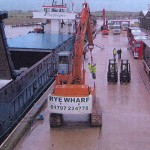
New Equipment Available
Today, with the new equipment available, Simon is able to unload 2,500 tonne of aggregate in less than half the time it took his father in 1999.
Simon Wood has gathered a fine team of stevedores around him, Richard White, Steve Brown and Kevan Crouch work with quiet efficiency on each cargo as it arrives. Time is of the essence for the Captain of each coaster. He needs to be unloaded and get back to sea at the earliest possible moment and only has a small margin of tome on each tide to turn round in the river and head out to pick-up a new consignment.
Philip Clarke another ex-Alsfords employee and Geoff Robus work inside the giant warehouses where tons of Talcum Powder and aggregate are stored at this time.
Wind Turbines
Negotiations are in an advanced stage for the importation through the Rastrum Wharf of the giant wind turbines that are coming from Germany destined for the Romney Marshes. If the negotiations are successful everything but the enormous blades will come in through Rye.
The office staff must not be forgotten, Gemma and Angela keep the paperwork in order.
There can be no doubt that the Rye, as a commercial Port, would have disappeared, save for the fishing, if Rod Chapman had not stepped in and rescued the Wharf.
“Rye’s Own” March 2008
All articles, photographs and drawings on this web site are World Copyright Protected. No reproduction for publication without prior arrangement. © World Copyright 2017 Cinque Ports Magazines Rye Ltd., Guinea Hall Lodge Sellindge TN25 6EG
